Podcast: Play in new window | Download (Duration: 18:39 — 29.7MB)
Subscribe: Apple Podcasts | Spotify | Amazon Music | Android | Pandora | iHeartRadio | JioSaavn | Podcast Index | Email | TuneIn | RSS | More
By Davy Crockett
![]()
![]()
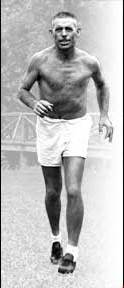

Paul Simpson was born in 1904. When he was a child on the family farm, he had to do the shopping. The nearest store was two miles away. Instead of walking, he ran the four miles to and from the store. He said, “I couldn’t see the point in wasting time walking the distance so I just dug my toes into the hot sand and ran the entire distance.” He began running regularly at age fifteen and won a mile race in high school.
| Please consider becoming a patron of ultrarunning history. Help to preserve this history by signing up to contribute a little each month through Patreon. Visit https://ultrarunninghistory.com/member |
Early Running
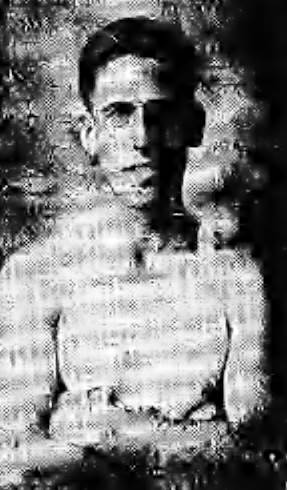

Once home, Paul decided to finish high school and still hoped to become a general by going to West Point. He was given the name of “Hardrock” by his high school classmates at Burlington high school where he “ran and ran on long straightaways or in circles. He wasn’t so fast, not as sprinters go, but he was durable and defiant to physical wear and tear.” He won the state title in the mile. While on the football team he never missed a play. He indeed was “Hardrock.”
Hardrock received an appointment to West Point, but when he finished high school, he decided not to accept it. Instead he entered Elon College where he starred on the track and field team in the 100-yard dash, low hurdles, javelin throw, and the two-mile run. He was also the captain of the cross-country team and set a state record in the 6-mile run.
Racing a Horse
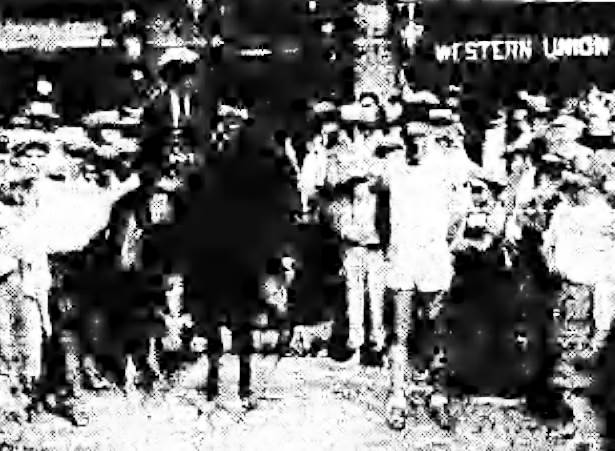

A ceremony sent away the two contestants with the town lining the streets to cheer him on. In the early stages he and the horse traded the lead, but by mile thirty-five, Hardrock took control. After 62 miles on the first day, the two exhausted contestants both turned in for the night. By the next afternoon, the horse was leading. Cars lined the roads cheering them on in the various towns.
While running through Raleigh, kids chased Hardrock and threw rocks at him. Other towns provided police escorts. Accounts about the finish on the third day vary and changed as Hardrock’s legend grew. The true story is that at about mile 144, a doctor determined that Hardrock’s foot was infected and that he needed to stop running. He did. The horse was in poor shape too, with stiff legs, five miles ahead of him. They both stopped. Hardrock did not win and was not awarded the $500 winner’s prize. The truthful story that his family helped compile after his death matched contemporary reports.
But the story changed in the years to come. Perhaps the city businessmen purposely told a different story. The changed version was eventually published in Ripley’s “Believe it or Not.” Believe it not. The story told through the years stated that Hardrock stopped racing when he learned that the horse dropped dead 25 miles behind him and that he won the $500 for beating the horse. This was not true. Perhaps after the false story was published and continually told, Hardrock decided to embrace it. It was a great story for the publicity that he and the city sought for. He didn’t correct dozens of news stories that were published over the years in his local newspaper that stated he won this 1927 race. For many of the articles he gave them the information. In 1954 he told reporters, “the horse gave up.” In 1960 he stated, “In 1927 I ran 144 miles and beat a horse by 25 miles. The horse had to quit, he got so stiff in the hips.”
The C.C. Pyle Bunion Derbies




With very little money, Hardrock hitchhiked all the way to Los Angeles for the race. In Alabama he pulled a man from the flames of a fire. He had to walk many miles across Texas because he couldn’t get a ride. While sleeping in New Mexico, someone slipped into his room and stole $84. Several people kindly helped him continue his trip to California. His sister put up the $300 entrance fee for him and many Burlington citizens sent him money once they learned about the robbery.




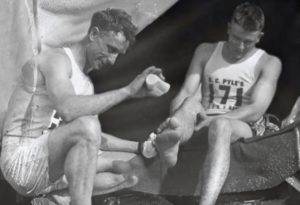

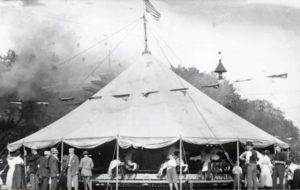

In Oklahoma, Hardrock was 214 hours behind the first place runner. Burlington hired a trainer to come out for him to help, his best friend from college, Wesley Williams. He greatly helped Hardrock, and by the time they reached Pennsylvania, Hardrock was running strongly and his problem foot had healed up. He started taking the lead in the daily segments and won one segment in upstate New York, climbing into 39th place.
The 84th day arrived for the finish at Madison Square Garden in New York City. Only 2,000 people were in the arena but Hardrock had a good cheering section of family and friends. Hardrock finished in 36th place out of 77 finishers. He returned to Burlington that week where the city lavished him with attention. By finishing he joined an elite company of runners who would be known through the ages as “Pyle Runners.”


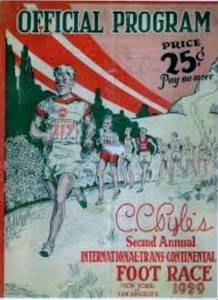

Hardrock was confident that he could win that year and stated it was “a dream come true” to be able to run with the financial support of various sponsors. He was in it to win it. Wesley Williams again supported him as his crew. In Oklahoma he was running in 4th place. In Arizona he was in 5th just 40 hours behind the leader. It rained 50 of those days, with downpours in the southwest. For some of the time they ran in snow and it was very cold running through New Mexico.
Hardrock finished 5th in Los Angeles, in 78 days, more than 30 hours ahead of the next runner, but 61 hours behind the winner. Only nineteen of the 104 starters made it to the finish. This high finish brought him national attention. He became recognized as being one of the “greatest marathoners ever.” He won $2,500 but he was never able to collect it, despite winning a lawsuit against Pyle. In a few months, Hardrock was hired by Elon college as the track coach.
Racing in Canada, 1930-31
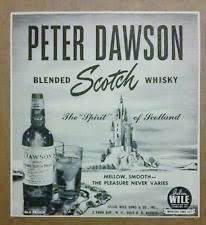

Hardrock didn’t train very hard for this very long race and didn’t last long in the relay because he had been struggling with sore feet. His trainer pulled him out of the race sometime after the third day in order to save him for future races. Hardrock’s partner was allowed to continue on with another runner who also had his partner drop out. Thirteen other teams finished. The last segment was a 26.2 marathon that finished in the Montreal Stadium, witnessed by 13,000 spectators.


In 1931, The British legend from South Africa, Arthur Newton (1883–1956) organized an indoor invitational 24-hour race in Hamilton, Ontario, Canada, hoping to break the 24-hour world record. Hardrock and other Pyle runners were invited to compete on a square, banked track, twelve laps to a mile, held in a tent. Various acts were performed in the inside area of the track to try to draw in spectators. Hardrock pulled a muscle in his leg but continued on and placed 4th with 116.5 miles. Newton was the winner with an impressive world record of 152 miles.
Also in 1931, Hardrock again ran in the 500-mile Peter Dawson relay teaming up with Canadian, Louis Thoraval. On one 47-mile day, Thoraval had a sore leg, so Hardrock ran the entire 47 miles himself allowing his partner to rest that day. A Montreal newspaper stated that he finished in 7th that day and said “The hero of the day was without any doubt Paul Simpson.” That year 17 teams started and the Simpson/Thoraval team finished in ninth out of ten surviving teams, with a time of 66:06, 13 hours behind the victors. 8,000 spectators witnessed the finish on a rainy day in a stadium in Montreal.
Back in Burlington, 1932
Hardrock took his toughness to the boxing ring in 1932 and took a drubbing in the opening round of his debut. It was a “savage” round. When his waistband snapped, he had to hold onto his trunks with one glove for the remainder of the round while the huge crowd “roared with laughter.” But he hung in there and knocked out his opponent, “Skeets King.” King said, “He is a hard rock alright.” That was Hardrock’s first and last match. He quit the sport because “there was no money it in.” Later in 1932 at Burlington, North Carolina, according to an Associated Press article published nationwide, Hardrock set what was believed to be an American and world professional six-mile record, covering the distance in 30:04.
Racing in Canada, 1933
In 1933 Hardrock ran in an individual 470-mile nine-day stage race from Montreal to Quebec and back with segments between 26-52 miles. It was organized by the Young Canadian Athletic Association. Perhaps this was a solo version of the Peter Dawson Relay that was held in 1930-31. He had trouble getting local sponsorship to fund his entry and travel expenses, but a Toronto real estate man helped him out and provided a “house truck” equipped with bath, sleeping quarters, and cooking arrangements. In a letter to home he wrote that he won every stage of the event, winning overall, and was awarded $1,000. He reported that 27 runners entered including other Pyle runners, and that ten finished. His finishing time was 60:54, several hours faster than when he ran as a relay in 1931. Nearly two decades later he claimed that during this race he set a world record 12-hour record of 90 miles.
No 1933 Canadian newspaper reports of this race were found, but it probably was held. The 1933 race description from Hardrock didn’t include a 90-mile segment. The 90-mile 12-hour record is very suspect and wasn’t mentioned in the local Burlington newspaper until 1949. It is believed that this record was either fabricated or the distance wildly short of 90 miles. As Hardrock sought the public spotlight and in later years would transition into a “solo artist,” by creating running events that attracting sponsorships, like other runners (even some today) he would claim a few obscure and unverifiable “world records.” In a letter from Canada to his local newspaper, Hardrock sounding a little like the future Mahammad Ali, and said, “I stand today the best real long distance man in the world, bar none.” He may have succumbed to the temptation of overstating his accomplishments at times as he did with the 1927 race against the horse. Nevertheless, during this era he had speed and endurance, and was one of the most colorful and talented ultradistance runners in America. He helped hundreds of thousands over the years understand that running ultradistances was possible.
While still in Canada that year, Hardrock attempted to break the Toronto-to-Hamilton 45-mile record. This didn’t appear to be part of a race. In later years he claimed that he broke “the record” with 5:07:40. This “record” claim is very suspect. It was not mentioned in his local newspaper until 1949 as he was seeking to get back into the public spotlight.
Seeking Prize Money and Providing for Family
In 1933 Hardrock was laid off from a brewery job and later found work as an ice delivery man. He was given time off by his boss to travel west to run a 34-mile race from Las Aniamas, New Mexico to La Junta, Colorado. His motivation was to break the course record and win some prize money. He boasted, “This race is already in the bag for me. This little race out in Colorado will be barely long enough to warm up on.” He did win against 21 others, covering the distance in 4:15. He came home with several hundred dollars of prize money. In 1934 he ran 34 miles in the Arkansas Valley Marathon, winning in 3:50. He thought this was a “world record” for 34 miles, but no one kept track of records for this odd distance.
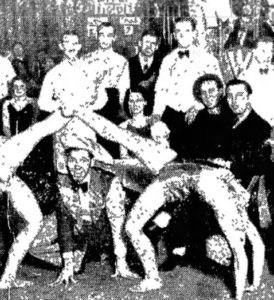

Still seeking prize money, Hardrock resorted to entering a walkathon. These bizarre and corrupt competitions/events were popular in the 1930s. See the article on Walkathons. He teamed up with a young lady to participate in such a contest that was held in to Greensboro in a large tent. He said, “I remember that the first week was a hardship and it was tough to keep going. I can still recall how my arms felt like logs, how my legs like two sticks, and how my eyes were so tired.” It didn’t end out well for him. One night he fell to the floor unconscious and was taken to the hospital in Greensboro, North Carolina, an ending that he never told. He recovered and the attending doctor announced that he was in good condition. He remained in the hospital for several days resting. Hardrock had competed in the walkathon for more than 62 days before he was disqualified. In later years, he never told about this unfortunate ending when he mentioned the walkathon. Once he recovered he sued for the arrest of Walkathon management, contending that he had been assaulted numerous times by the professionals in the event. Two men were arrested. The management eventually settled with him for a portion of the prize money.
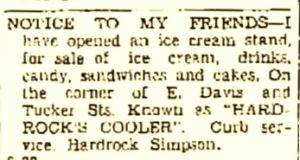

With his eyes on the Berlin Olympics, in 1936 Hardrock tried to convince an amateur board to grant him amateur status. He presented data showing that the prize money that he actually received was far less than his actual expenses. Even though he wasn’t eligible for the Olympics, he registered for the Olympic trials at the Boston Marathon. He grew a handle-bar mustache as a disguise, used “Paul Simpson” as his name, and gave a Florida address. He placed fifth with a time of 2:43, but did not make the Olympic team.
Hardrock sought to return to one of his roots in 1937, to race against a horse. He wanted to race a horse for 50 miles. Local men boasted that they could enter a horse “that will keep Simpson in a dust cloud behind trotting hoofs until he has had enough and goes out on the count.” Hardrock’s main motivation was to win a portion of bets taken against him. Apparently the “man vs horse” race was not held that year, but Hardrock pushed on to pursuade the 1939 San Francisco World Fair to hold a 24-hour race against a horse. His letterhead stated he was a “world champion runner.” The man in charge of the sport expo gave a tongue-in-cheek answer and suggested that Hardrocket “run over to San Francisco some afternoon to talk things over.”
Temporary Retirement From Running
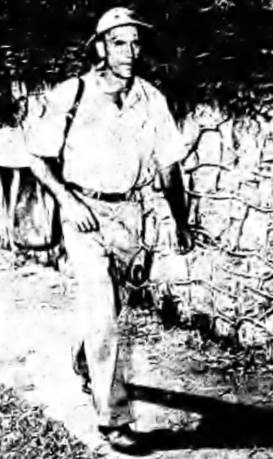

After 1939, at the age of 35, Hardrock retired for about ten years from running competitions and exhibitions, but he would still visit track and field events at nearby colleges. He also continued to run three times a week and worked out with weights the other days. In 1942, Hardrock became a mail carrier and would work on the same route for the next 32 years. Originally he ran his route so fast that he made others wondered why the other mailmen couldn’t do the same. His supervisor told him to slow down. That year he applied to join the marines at the age of 38. Someone from the local marine recruiting station stopped by the post office to interview him. When asked if Hardrock could “take it”, Hardrock talked about his coast-to-coast runs, that he held a world record for a 45-mile run, a 90-mile run completed in 12 hours and participated in a walkathon for 1,490 consecutive hours. The recruiter replied, “man you shouldn’t be an applicant, you should be a general.” Hardrock was too old to qualify.
Running again


Hardrock became more proactive to promote his running career in the newspapers. When reviewing his running career, he said he had little to show for it except: an excerpt in “Ripley’s Believe it or Not” book about his 1927 run against the horse (which incorrectly stated that he won), two unofficial world records (which are doubtful), and “first hand knowledge of geography and typography of the United States and Canada.”
More Publicity


Someone came up with the brilliant idea for Hardrock to team up with local minor-league baseball games. He would run around the fields during games. For example, during a double-header game (Burlington vs. Greensboro), he ran around the inside barrier of the park 111 times for 26.6 miles. He repeated this stunt many times during the coming years. It was a very successful side-show, beneficial to both Hardrock and to baseball. He added more sponsored runs in 1952 including many baseball games and he also started to run between towns. Each time he was sponsored, the business would offer awards for guessing Hardrock’s time. In 1953 Hardrock appeared on the “Two for the Money” radio game show and won $70.
Racing Again
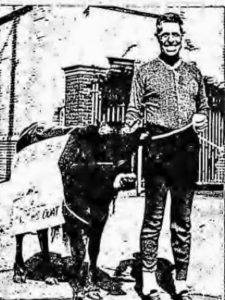

At Tabor City, he came in second in a 15-mile walking contest, a race he had won the previous year. With this defeat, news stories included headlines that stated he was not the world champion that he claimed to be. The small story was published in newspapers nationwide. He walked the race once more in 1956, and again finished in second.
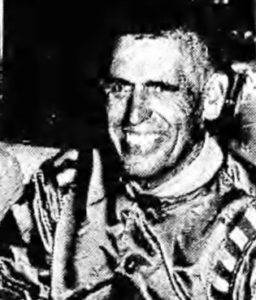

In 1957 Hardrock failed to finish his 53-mile birthday, quitting due to cramping at 38 miles. He ran it again the following month. “I did it for my own personal satisfaction. I feel a lot better about myself now.” Even though age 53 was still not very old for the typical ultrarunner, perhaps all his lifetime miles were catching up to him. It definitely was becoming more difficult for him to run ultradistances.
Racing Horses and Mules
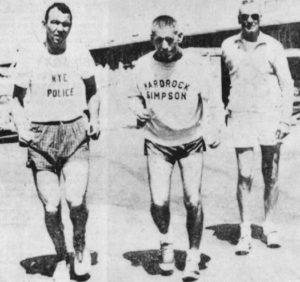

In 1958 Hardrock again ran against a horses. This time in a 157-mile race in Utah, with two other veteran professional runners. See the Man vs. Horse article for all the details about this race. A horse won and was more than 57 miles ahead of Hardrock when it finished. Hardrock went on until mile 118. Curiously, Hardrock continued to have difficulty telling the truth about his races with horses. Two years later he inaccurately told a reporter, “In Utah in 1957 one horse beat me by two hours. We ran from Salt Lake City to Roosevelt, but he dropped dead.” No horse dropped dead and Hardrock didn’t finish. This version of the race evolved into a story that he ran a horse to death in this race and finished 157 miles in 31 hours. No, he reached 118 miles in about 35 hours, which was about ten hours after the NYC policeman dropped out at about the same point.
Without ever beating a horse, Hardrock turned to racing a mule as part of Benson, North Carolina’s annual “Mule Day” celebration. He wanted the course to be 30 miles, but it was cut to 18 miles. The crowds along the route were numbered at about 15,000 people. Hardrock had to walk, but the mule trotted along the route as Hardrock kept up a brisk walk wearing shorts and was bare-chested. The mule won by 15 minutes. Hardrock complained, “It wasn’t a long enough race.”
The 30-mile race he wanted against the mule took place the next year. Maude the mule again beat Hardrock, this time by 20 minutes. Before the race Hardrock had insisted that the person riding the mule couldn’t switch off, but the rider became sore and exhausted, so they were switched out several times. It was quite a side-show with a clown running with Hardrock for the final miles.
In 1960, Hardrock was featured in a Sports Illustrated article


At age 57, Hardrock was asked in 1961 when he would stop running. His reply was, “As long as I feel as good as I do now and keep making money and can stay in shape, I plan to keep on. I enjoy traveling around and meeting people and getting the reaction of the public. I’m a curiosity to them.”


In 1977 Hardrock experienced several small strokes and then had a big one in 1978. He died at the age of 73 with about 160,000 lifetime miles. In the newspaper article announcing his death it ended with, “Now, philosophers will argue whether he might have lived longer if he had left running to someone else, or if he would have died 10 years ago without it.”
Today, at a historical railroad depot, in Burlington, North Carolina, there is a mural on the wall honoring the city’s favorite running hero. He is depicted as a young-looking Hardrock in his running trunks. Today, few remember him, but he deserves to be in a prominent position in America’s ultrarunning history for that era.
